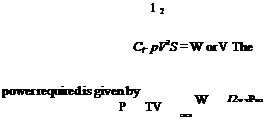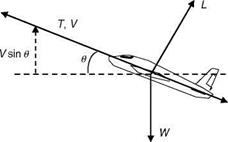A10 PERFORMANCE OF AN AIRCRAFT
A few important aspects of flight vehicle performance are mentioned here.
The drag force acting an aircraft is typically a function of the lift coefficient and Mach number.
|
Cd = f (Cl, M) |
|
The equation for aircraft drag polar, given by Equation A.22, can be expressed as Cd = CDo + KC2l (A.38) where K can be estimated from flight data using parameter-estimation techniques. The theoretical value for the drag-due-to-lift factor K at subsonic speeds is given by 1/pAe, while its value at transonic and supersonic speeds is close to 1/Cl. Assuming thrust T to be inclined at angle sT with the flight path direction, the equations of motion for a level (U = 0) unaccelerated flight can be expressed as |
|
T cos sT = D T sin sT + L = W |
|
(A.39) |
|
For small values of sT, Equation A.39 becomes |
|
T = D L=W |
|
(A.40) |
|
Rearranging Equation A.40, the required thrust for an unaccelerated level flight is given by |
|
W |
|
(A.41) |
|
L/D |
|
Thus, minimum thrust is required where L/D is maximum. If V is the velocity of the aircraft during level unaccelerated flight, and the lift is equal to weight, we have |
|
I 2W VpScL |

|
/2W3c2 V pSC3l |
|
(A.42) |
|
FIGURE A11 Airplane in a steady climb. |
Another important parameter in aircraft performance is the rate of climb. Compared to the level unaccelerated flight, the thrust in this case, in addition to overcoming drag, will also be required to compensate for the component of weight (Figure A11).
T = D + W sin U
The vertical velocity component gives the rate of climb, as shown in Figure A11.
Rate of climb = V sin U
The topic of performance is incomplete without the mention of engines used for propulsion. The piston engines with propellers still rule the roost in low-speed flights while gas turbine engines are used for jet propulsion at higher speeds. Turbo jets are equipped with a compressor, a combustion chamber, turbine, and exhaust nozzle. Thrust is provided by reaction of the exhaust gases thrown backward through the nozzle. Another type is the turbofan or the bypass engine, which has a large fan that accelerates the air ahead of the compressor, thus resulting in more thrust with higher efficiency. While turbojet and turbofan engines have rotating parts, there is another type called the ramjet, which uses the ram effect generated from the forward speed to pass the compressed air to the combustion chamber and out of the exhaust nozzle at very high speeds. As is obvious, ramjet will give no thrust at zero forward speeds.












